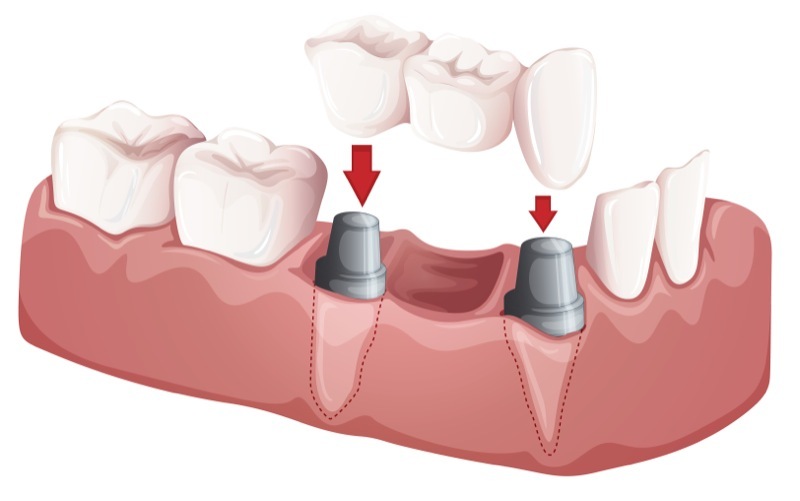Dental Bridges: The Procedure
Replace Missing Teeth With Our New Jersey Dentists
Are you ready to smile confidently again? With dental bridges, our dentists in New Jersey can replace your missing teeth and restore function to your smile. Don’t wait any longer! Contact our dental office today by calling our Mays Landing office at (609) 625-3499 or our Somers Point office at (609) 927-8448 to schedule your consultation.
Our New Jersey dentist explains the dental bridge procedure to ensure you know what to expect.
How the Dental Bridge Procedure Works

Dental bridges are an effective solution for people who have missing teeth. They’re used to bridge the gap between teeth by anchoring a false tooth (pontic) to the surrounding natural teeth (abutments). The dental bridge process involves several steps, including consultation and evaluation, preparing the abutment teeth and placing a temporary bridge, fitting and placement, and a follow-up appointment.
Components of a Dental Bridge
A dental bridge consists of the following components:
- Pontic: This is the term for the artificial teeth, or teeth, that replace the missing natural teeth. Pontics can be made from various materials including porcelain, gold, alloys, or a combination of these materials. Traditional dental bridges, the most common type, utilize pontics made from ceramic or porcelain fused to metal.
- Abutment Teeth: These are the natural teeth or dental implants on either side of the gap. They serve as support for the bridge. If natural teeth are used, they’re often reduced in size to accommodate the bridge.
- Retainers or Dental Crowns: These are fixed onto the abutment teeth and hold the pontic in place. They can be made of similar materials as the pontics. Depending on the design of the bridge, these can be full crowns that cover the entire abutment tooth or partial coverage like inlays or onlays.
- Connectors: These are the parts that connect the pontic to the retainers or crowns. They can be rigid (as in conventional bridges) or non-rigid (as in some types of removable bridges). Resin-bonded bridges, also known as Maryland bridges, present a more conservative alternative, utilizing a metal or porcelain framework with wings bonded to existing teeth.
- Framework: In some bridges, there’s a metal or porcelain framework that provides additional strength and support.

The Dental Bridge Process
Consultation and Evaluation
The first step in the dental bridge process is a consultation with our New Jersey dentist. During this appointment, Dr. Nosti will evaluate your oral health, including your teeth and gums, and discuss your options for replacing missing teeth, including the various types of dental bridges such as traditional, cantilever, and Maryland bridges. They may also take digital X-rays and impressions of your existing teeth, to create a model of your mouth, ensuring your custom bridge is a perfect fit.
At this appointment, They’ll also recommend the best dental bridge type. They may recommend a traditional dental bridge, implant-supported bridges, or another option.

Preparing Abutment Teeth and Placing a Temporary Bridge
Once our dentist has determined that a dental bridge is the right option for you, they’ll prepare the abutment teeth. If a cantilever dental bridge is chosen, the preparation may differ as it is held in place by a dental crown cemented to only one abutment tooth, potentially requiring the alteration of just one natural tooth next to the gap. This involves removing a small amount of enamel from the teeth that will support the bridge. For a Maryland dental bridge, preparation involves a minimal impact on the abutment teeth, using a framework of metal or porcelain bonded onto the backs of these teeth, ideal for missing front teeth. Dr. Nosti will then take another impression of your teeth to create a mold of your mouth which will be used to create your permanent bridge.
While your permanent bridge is being made, we’ll place a temporary dental bridge to protect your abutment teeth and help you eat and speak normally while waiting for your permanent restoration to be created.
Fitting and Placement
Once your permanent bridge is ready, you’ll return to our Mays Landing and Somers Point dental office for the fitting and placement appointment. During this appointment, Dr. Nosti will remove the temporary bridge and fit the permanent bridge to your abutment teeth. They’ll then make any necessary adjustments to ensure a comfortable fit. With dental cement, it will be set into place.
Follow-up Appointment
After your bridge has been placed, we’ll schedule a follow-up appointment to ensure that everything is healing properly. During this appointment, Dr. Nosti will check the fit of your bridge and make any necessary adjustments. They’ll also provide instructions on how to care for your new bridge to ensure its longevity.
Post-Procedure Care
After your dental bridge procedure, there are certain practices that you’ll need to follow, including:
- Oral Hygiene Habits: Keeping the remaining teeth healthy and strong is crucial for the longevity of the dental bridge. Regular brushing, flossing, and dental check-ups are essential. It’s also important to prevent tooth decay to ensure the health and stability of both the dental bridge and the remaining natural teeth.
- Dietary Adjustments: Initially, you’ll want to stick with eating soft foods and avoid anything that could put undue pressure on the new bridge.
- Regular Check-ups: Regular visits to the dentist can ensure the bridge remains intact and the adjacent teeth remain healthy.

Frequently Asked Questions
Are there any potential risks or complications associated with getting a dental bridge?
While dental bridges are generally safe and well-tolerated, some potential risks and complications may include sensitivity, discomfort, or gum irritation after the procedure. In rare cases, there may be an allergic reaction to the materials used in the bridge. Patients must follow their dentist’s aftercare instructions to minimize any potential issues.
Will the dental bridge procedure be painful?
Most patients experience minimal discomfort during the dental bridge procedure. The dentist will use a local anesthetic to numb the area around the teeth being treated, ensuring the patient is comfortable throughout the process. After the procedure, there may be slight soreness or sensitivity, which usually subsides within a few days. Over-the-counter pain relievers or prescribed medications can help manage any post-procedure discomfort.

Replace Your Missing Teeth With an Implant Supported Dental Bridge
Ready to have a complete smile? Schedule your appointment with our Mays Landing and Somers Point dentists today by contacting our dental office at our Mays Landing office at (609) 625-3499 or our Somers Point office at (609) 927-8448. Dr. Nosti will evaluate your case and discuss dental bridges with you.


